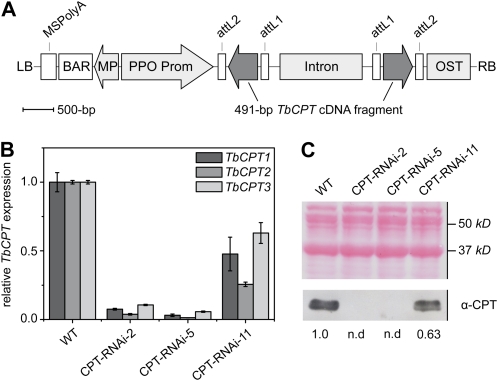Figure 1.
RNA silencing of TbCPT1 to -3 in transgenic T. brevicorniculatum CPT-RNAi lines. A, Schematic representation of the CPT-RNAi vector. The 491-bp TbCPT cDNA fragment was used as a trigger for RNAi under the control of the T. officinale latex-specific PPO promoter (PPO Prom). attL1/2, attL cassette frame; BAR, basta resistance gene; Intron, chalcone synthase intron from P. hybrida; LB, left border; MP, mannopine synthase promoter; MSPolyA, mannopine synthase poly(A) signal; OST, octopine synthase poly(A) signal; RB, right border. B, Quantitative RT-PCR analysis of TbCPT1 to -3 mRNA expression in the latex from roots of transgenic CPT-RNAi lines and in a wild-type (WT) control. The expression levels were normalized to TbGAPDH and set as 1 for the wild type. C, Protein analysis of transgenic CPT-RNAi lines and a wild-type control. Latex samples were used for protein separation by SDS-PAGE and subsequent western-blot analysis. The top image shows Ponceau S staining of the nitrocellulose membrane after protein transfer. This membrane was used for a western blot using a TbCPT-specific α-CPT antibody (bottom image). Numbers below the blot indicate signal intensities relative to the wild-type value. n.d., No signal detectable above background. [See online article for color version of this figure.]

